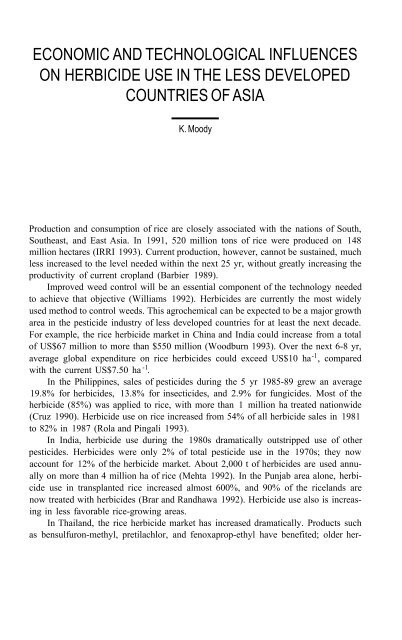HERBICIDES in Asian rice - IRRI books - International Rice ...
HERBICIDES in Asian rice - IRRI books - International Rice ...
HERBICIDES in Asian rice - IRRI books - International Rice ...
Create successful ePaper yourself
Turn your PDF publications into a flip-book with our unique Google optimized e-Paper software.
ECONOMIC AND TECHNOLOGICAL INFLUENCES<br />
ON HERBICIDE USE IN THE LESS DEVELOPED<br />
COUNTRIES OF ASIA<br />
K. Moody<br />
Production and consumption of <strong>rice</strong> are closely associated with the nations of South,<br />
Southeast, and East Asia. In 1991, 520 million tons of <strong>rice</strong> were produced on 148<br />
million hectares (<strong>IRRI</strong> 1993). Current production, however, cannot be susta<strong>in</strong>ed, much<br />
less <strong>in</strong>creased to the level needed with<strong>in</strong> the next 25 yr, without greatly <strong>in</strong>creas<strong>in</strong>g the<br />
productivity of current cropland (Barbier 1989).<br />
Improved weed control will be an essential component of the technology needed<br />
to achieve that objective (Williams 1992). Herbicides are currently the most widely<br />
used method to control weeds. This agrochemical can be expected to be a major growth<br />
area <strong>in</strong> the pesticide <strong>in</strong>dustry of less developed countries for at least the next decade.<br />
For example, the <strong>rice</strong> herbicide market <strong>in</strong> Ch<strong>in</strong>a and India could <strong>in</strong>crease from a total<br />
of US$67 million to more than $550 million (Woodburn 1993). Over the next 6-8 yr,<br />
average global expenditure on <strong>rice</strong> herbicides could exceed US$10 ha -1 , compared<br />
with the current US$7.50 ha -1 .<br />
In the Philipp<strong>in</strong>es, sales of pesticides dur<strong>in</strong>g the 5 yr 1985-89 grew an average<br />
19.8% for herbicides, 13.8% for <strong>in</strong>secticides, and 2.9% for fungicides. Most of the<br />
herbicide (85%) was applied to <strong>rice</strong>, with more than 1 million ha treated nationwide<br />
(Cruz 1990). Herbicide use on <strong>rice</strong> <strong>in</strong>creased from 54% of all herbicide sales <strong>in</strong> 1981<br />
to 82% <strong>in</strong> 1987 (Rola and P<strong>in</strong>gali 1993).<br />
In India, herbicide use dur<strong>in</strong>g the 1980s dramatically outstripped use of other<br />
pesticides. Herbicides were only 2% of total pesticide use <strong>in</strong> the 1970s; they now<br />
account for 12% of the herbicide market. About 2,000 t of herbicides are used annually<br />
on more than 4 million ha of <strong>rice</strong> (Mehta 1992). In the Punjab area alone, herbicide<br />
use <strong>in</strong> transplanted <strong>rice</strong> <strong>in</strong>creased almost 600%, and 90% of the <strong>rice</strong>lands are<br />
now treated with herbicides (Brar and Randhawa 1992). Herbicide use also is <strong>in</strong>creas<strong>in</strong>g<br />
<strong>in</strong> less favorable <strong>rice</strong>-grow<strong>in</strong>g areas.<br />
In Thailand, the <strong>rice</strong> herbicide market has <strong>in</strong>creased dramatically. Products such<br />
as bensulfuron-methyl, pretilachlor, and fenoxaprop-ethyl have benefited; older her-

















